Blog
Targeting Different Hair Types and Body Areas with Ulike Air 10
Targeting Different Hair Types and Body Areas with Ulike Air 10
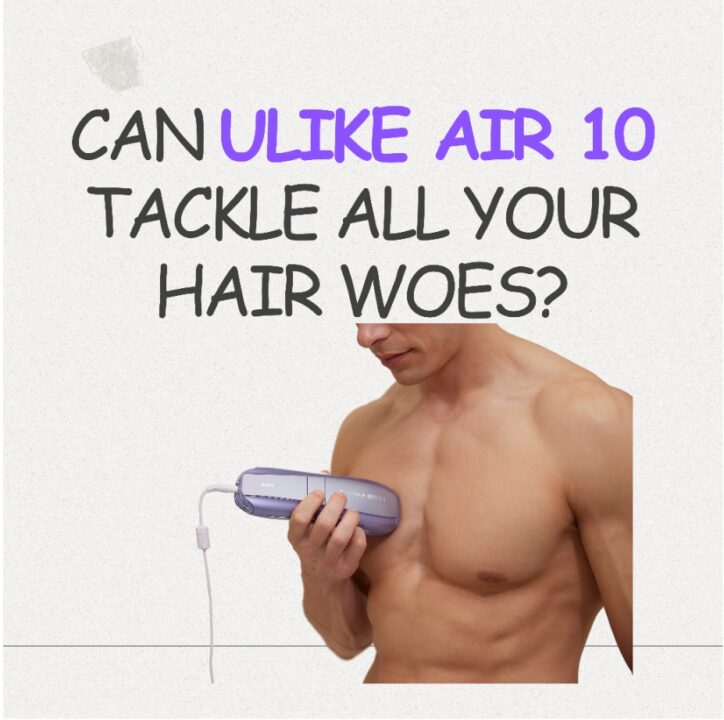
Have you been itching to try the new Ulike Air 10? Well, I finally got my hands on it, and let me tell you, I’ve been busy putting it to the test on all sorts of body parts. I wanted to see if it could really live up to the claims of being a one-size-fits-all hair removal solution.
Honestly, I wasn’t just flying solo on this one. I enlisted a few friends to share their experiences using the Air 10 on different areas too. This way, we could get a broader picture of how it performs.
First thing I noticed? This device feels legit. Like, seriously powerful. It almost reminds me of a miniaturized Iron Man suit for tackling unwanted hair! But with all these fancy features – SHR mode, dual lights, the whole skin sensor and ice cooling thing – I had to see if it could really handle everything from my legs to, ahem, more sensitive zones.
So, get ready for the nitty-gritty! We’re about to deep dive into how well the Ulike Air 10 works on different parts of the body. Can it truly be the holy grail of at-home hair removal? Stick around to find out what we discovered!
Finding the Right Power for the Job
One thing that really impressed me with the Air 10 was how it catered to different body areas. Think about it – your legs have way thicker hair than your underarms, right? And your bikini line probably needs a more gentle touch than your shins.
Here’s where the Air 10’s power modes came in super handy. It has four settings: Maintenance, Normal, High, and SHR.
Let me break them down for you:
- Maintenance Mode: This is basically like a quick touch-up. Perfect for those fine hairs that might have popped up between sessions. It’s gentle and uses a high flash speed to keep things smooth without a full-blown hair removal battle.
·
- Normal Mode: This is your go-to for most areas. It’s a medium power level with a medium flash speed, making it ideal for taking care of regular or fine hair growth.·
- High Mode: Got stubborn, thick hair? This mode cranks up the power and slows down the flash speed. This one-two punch tackles those tougher areas, zapping hair right at the root.·
- SHR Mode: This is where things get interesting. Similar to High Mode, it has a high power level, but with a medium flash speed. This makes it perfect for sensitive areas like the bikini line. The slower flash feels gentler on the skin, but still packs a punch against unwanted hair. This SHR mode is a real game-changer – I haven’t seen it on many other IPL devices, and it makes a big difference!
Pro Tip Alert! The Air 10 even comes with detachable heads, which is a great way to maintain hygiene when switching between different areas.
Winning the War on Peach Fuzz
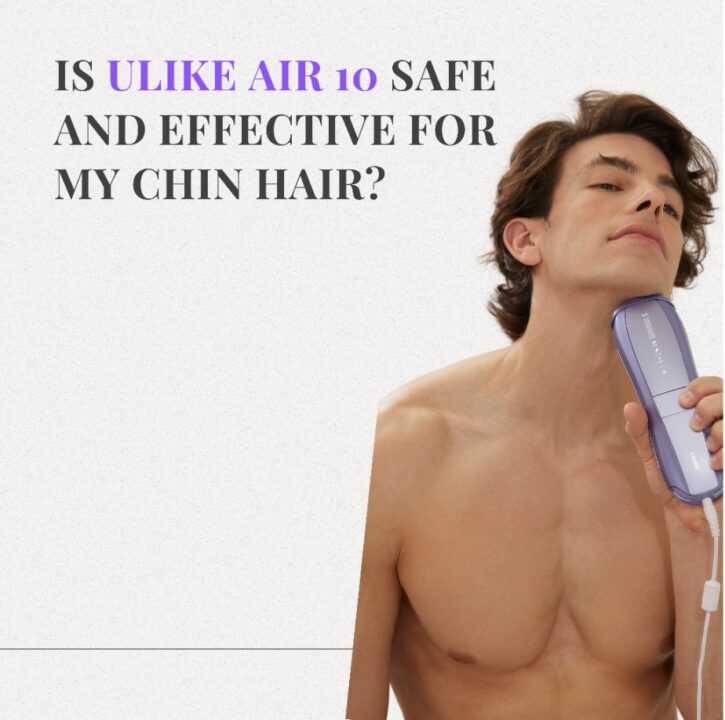
Let’s talk about my biggest concern: facial hair. I was honestly a little nervous about using the Air 10 on my face, since the skin there is so much more sensitive than, say, my legs. But here’s where the SHR mode truly became a champion. This setting uses a lower flash speed with a powerful zap, making it perfect for those fine hairs on your face without feeling like it’s scorching your skin.
Speaking of scorching, the built-in skin sensor on the Air 10 was another lifesaver. This little feature basically acts like a bodyguard for your skin. If it detects an area that’s not suitable for treatment, the device won’t activate at all. Pretty cool, right?
But the real MVP for facial hair removal was the Air 10’s sapphire ice-cooling technology. Let me tell you, it’s a game-changer! Even after a 30-minute session, my face felt soothed and refreshed, not irritated or tender.
Here are some bonus tips I picked when it comes to using the Air 10 on your face:
- Start Low and Slow: Always begin with the lowest setting to see how your skin reacts. There’s no point in jumping straight to high power if your face isn’t ready for it.
- Patch Test First: This is a golden rule! Do a small test patch on an inconspicuous area of your face to see if you experience any redness or irritation before going all-in.
- Eye and Brow Caution: Be extra careful around your eyes and eyebrows. These areas are incredibly sensitive, so it’s best to consult a professional for hair removal in these spots.
Conquering the Bikini Zone and Beyond
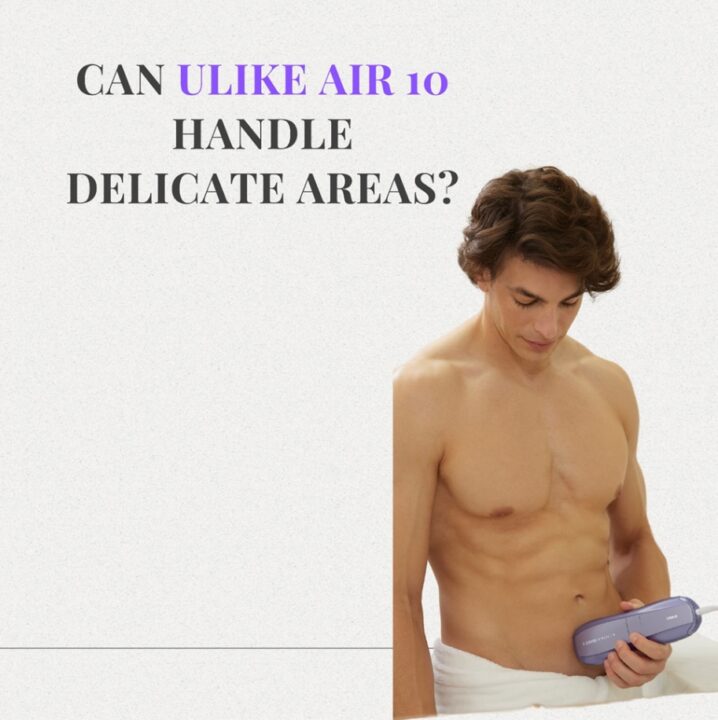
Let’s get real: some areas require a more delicate touch when it comes to hair removal. The bikini line and underarms are prime examples. Here’s where the Ulike Air 10 truly impressed me with its precision and control. The heat distribution felt incredibly targeted, zeroing in on unwanted hair without blasting the surrounding skin.
Once again, the SHR mode became my BFF. This setting, along with the built-in UV filter, felt like putting my sensitive skin in a safety bubble. The SHR mode’s gentle power combined with the filter’s protection for the top layer of skin (epidermis) made me feel confident using the Air 10 on these delicate areas.
But wait, there’s more! The sapphire ice cooling was the ultimate comfort factor. Even after tackling those trickier zones, my skin felt soothed and cool, not raw or irritated.
Here are some extra pointers I picked up for a truly smooth experience:
- Low and Slow Wins the Race: Always start with the lowest power setting and gradually increase it as your skin gets accustomed.
- Prepping Makes Perfect: For better light penetration (which helps the device work more effectively), make sure to trim or shave the area beforehand.
- Soothe and Moisturize: After your treatment, apply a gentle lotion to keep your skin hydrated and comfortable.
Taming the Thick and Stubborn
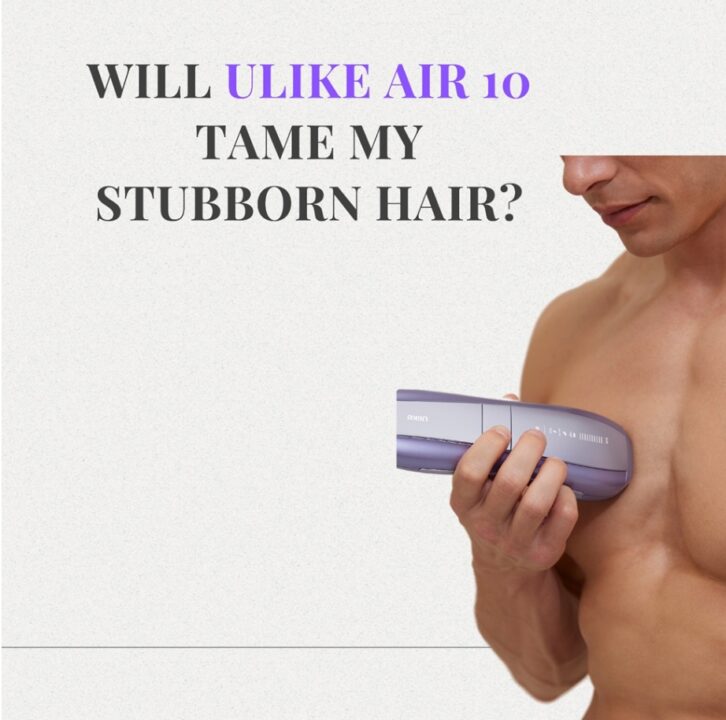
Let’s face it, coarse hair can be a real beast to tackle when it comes to hair removal. But the Ulike Air 10 totally transformed the game for me with its SHR mode. This setting packs some serious power, strong enough to stand up to even the most stubborn hairs.
The secret weapon? The combination of SHR mode with the Air 10’s dual lamps. This tag-team delivers a powerful zap that feels almost like laser technology, effectively targeting and disabling those coarse hairs at the root. The heat generated during this process is what vanquishes those stubborn foes.
Here are some battle tactics I picked up to further maximize the Air 10’s effectiveness against coarse hair:
- Multiple Sessions are Key: For stubborn hair, don’t expect a one-and-done situation. Multiple sessions are usually necessary to achieve the desired results.
- Consistency is Your Ally: Sticking to a regular treatment schedule is crucial for long-term hair reduction. Think of it as wearing down the enemy over time.
- Know Your Skin Tone: Using the correct settings for your specific skin tone is vital. Refer to the Air 10’s instructions to find the perfect power level for both effectiveness and safety.
Unveiling the Cost: Is the Ulike Air 10 Worth the Investment?
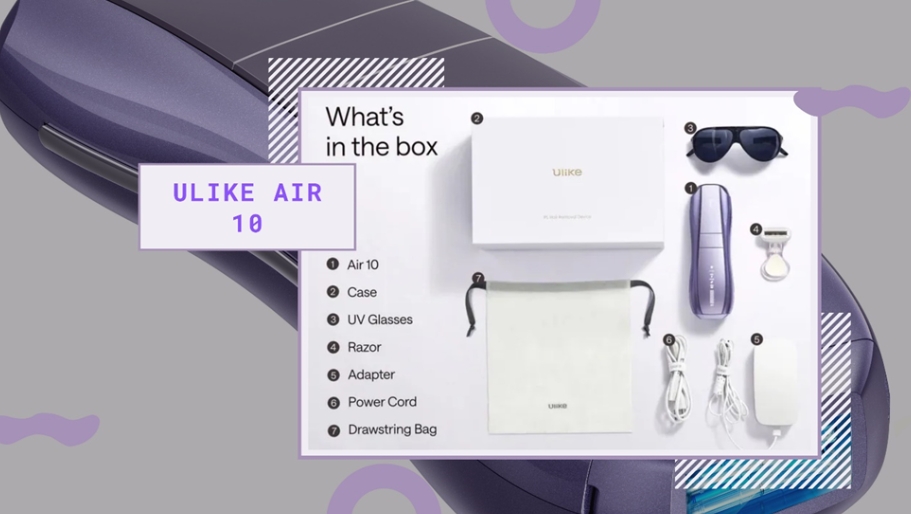
Alright, let’s talk about the bottom line – money. The Ulike Air 10 rings in at $399, but hold on! They often have deals that can knock the price down. Here’s the breakdown:
- Regular price: $339 (phew, a bit better!)
- Deals and discounts: Sometimes they have sales that bring it down to a cool $319.
- Secret code score: If you can find a discount code online, you might even snag it for a steal at $299.90!
Now, compared to similar products like the Flasher 2.0 by Nood or other hair removal gadgets, the Air 10 might seem a bit steeper in price.
But here’s the real question: Do the other hair removal gadgets work as well as the Ulike? Based on my experience (and the experiences of others!), a resounding NO is the answer.
Safety Seals of Approval
Let’s address a big concern – safety. The Ulike Air 10 isn’t some fly-by-night gadget. It’s actually backed by real medical professionals and a whole lot of credibility.
Here’s what puts my mind at ease:
- Dermatologist Approved: Dr. Davin Lim, a certified laser and procedural dermatologist, vouches for the Air 10, stating it allows women to safely remove hair at home. Having a professional’s stamp of approval is a major confidence booster!
- Clinically Tested & Cleared: The Air 10 isn’t just someone’s science experiment. It’s clinically proven to be safe and has secured FDA clearance. That means it’s undergone rigorous testing to ensure it meets safety standards.
- SGS-Tested & Award-Winning: The Air 10 goes above and beyond with SGS testing, a globally recognized safety certification. Plus, it’s been endorsed by Nobel laureates, adding another layer of trust.
In short, the Ulike Air 10 seems to be a safe and effective option for at-home hair removal, backed by science and medical expertise.
The Ulike Air 10: My Honest Take on At-Home Hair Removal
Let’s cut to the chase: I put the Ulike Air 10 to the test in different areas, and it delivered! Here’s the real deal from my perspective:
- Powerhouse Performance: This device packs a punch. Whether it was tackling fine facial hair or stubborn leg fuzz, the Air 10 rose to the challenge with its various power modes. No more struggling with a one-size-fits-all approach!
- Safety First: My skin is no battleground. The built-in safety features, like the skin sensor and SHR mode for sensitive areas, gave me peace of mind while using the Air 10.
- Comfort Counts: Let’s face it, hair removal isn’t always a picnic. The Air 10’s ice-cooling technology was a game-changer, especially on delicate areas. Goodbye, post-treatment ouch!
This wasn’t just my experience. Several testers echoed these positive results. They, too, found the Air 10 to be a flexible and effective at-home hair removal solution.
Now, is it perfect? Probably not for everyone. As always, consulting a dermatologist before using any new hair removal device is a smart move.
But if you’re looking for a powerful, customizable, and comfortable at-home hair removal option, the Ulike Air 10 is definitely worth checking out.
Blog
Candizi: Your Candy Just Got a Tech Upgrade (And It’s Deliciously Personal)
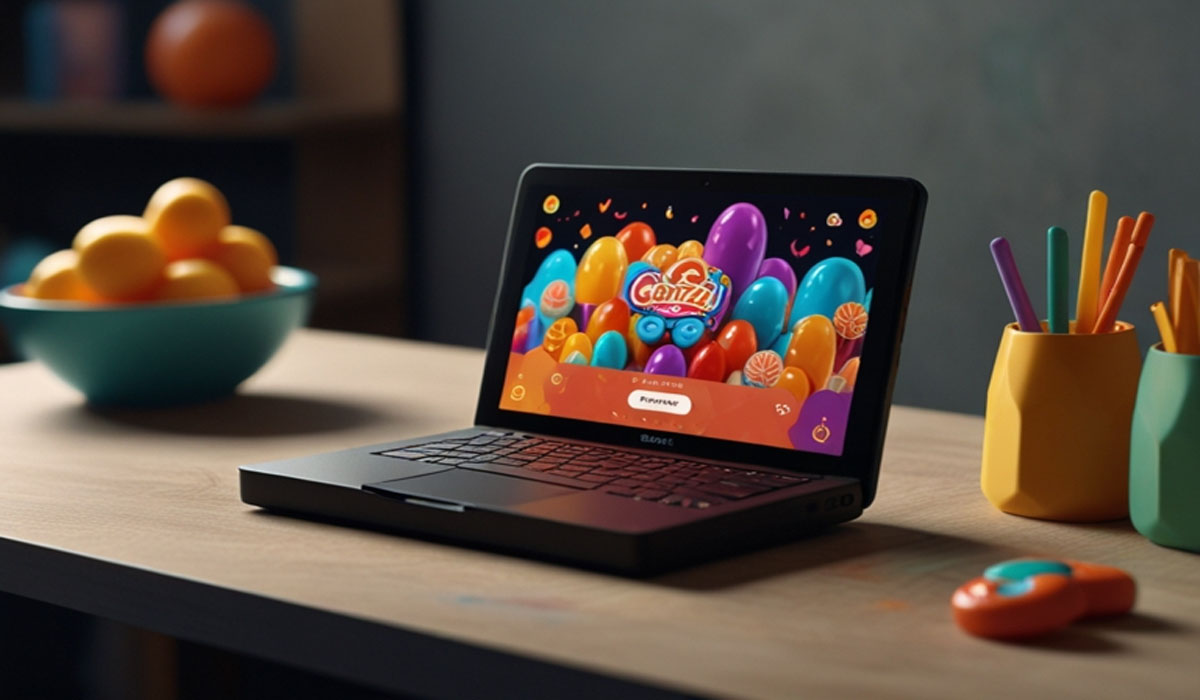
Remember that feeling? Staring into a sea of nearly-identical candy bars or gummy bears, wishing you could just create the perfect sweet – the exact flavor explosion, the ideal texture, maybe even a boost that suits your mood or your gut? It felt like a childhood dream, forever out of reach. Until now. Enter Candizi. Forget mass-produced sugar hits; this is candy, reimagined by AI, powered by you, and wrapped in a digital experience as vibrant as the treats themselves. Think Willy Wonka meets Silicon Valley, and you’re getting close. Candizi isn’t just selling candy; it’s selling a personalized, playable, utterly shareable moment of joy.
Gone are the days of settling. Candizi puts you firmly in the candy creator’s seat. Using their sleek online platform or app, you become the master confectioner. Choose your base (chewy gummy? Smooth chocolate? Crispy candy shell?), dial in wild or sophisticated flavors (think passionfruit-yuzu or black sesame-honey), pick a playful or elegant shape, and select colors that pop. Feeling adventurous? Let Candizi’s AI be your flavor sommelier. Tell it your preferences (“I love tart!” or “Surprise me!”), your mood (“Need comfort” or “Celebrating!”), or even wellness goals (“Low sugar, please”), and watch it suggest mind-blowing combinations you’d never dreamt of. This is candy, deeply personal.
Your Candy, Your Rules: The Candizi Creation Engine
So, how does turning your wildest candy fantasy into reality actually work? Candizi makes it intuitive and fun:
- The Canvas: Start with your base. This is your candy’s foundation. Options range from classic vegan gummies and rich chocolates to innovative textures like popping candy-infused shells or creamy nut butters.
- Flavor Alchemy: Dive into the flavor library. Browse categories (Fruity, Creamy, Spicy, Herbal) or search specific tastes. Want mango-chili-lime? Go for it. Craving lavender-white chocolate? Absolutely. This is where uniqueness shines.
- Shape & Style: Is it a tiny dinosaur? A geometric gem? A custom initial? Candizi offers a range of fun and chic shapes to match your creation’s personality.
- Color Splash: Make it visually stunning. Pick single hues, ombre blends, or vibrant patterns. Your candy should look as incredible as it tastes.
- The AI Boost (Your Secret Ingredient): Stuck? Indecisive? Curious? Hit the “AI Inspire” button. Feed it clues:
- “I’m feeling nostalgic for summer camp.” (AI might suggest s’mores-inspired chocolate with graham cracker bits and toasted marshmallow flavor).
- “Need an energy lift without caffeine, fruity preferred.” (AI could propose a gummy with guarana and acai, naturally sweetened).
- “Surprise my partner who loves floral and dark chocolate.” (AI crafts a dark chocolate rose petal truffle with a hint of blackberry).
- Wellness Tweaks (Optional): For those seeking a smarter indulgence, Candizi integrates options like:
- Probiotic boosts
- Adaptogens (like ashwagandha for calm, rhodiola for focus)
- Vitamin fortification
- Natural sweeteners (stevia, monk fruit) or reduced sugar formulas.
Candizi vs. The Candy Aisle: Why Personalization Wins
| Feature | Traditional Candy | Candizi Experience |
| Choice | Limited pre-set combinations | Endless Customization: Base, Flavor, Shape, Color |
| Innovation | Slow, mass-market trends | Instant Creativity: Your unique ideas + AI magic |
| Relevance | Generic appeal | Deeply Personal: Tailored to your taste & needs |
| Engagement | Purchase & consume | Co-Creation Playground: Design, share, collect (NFT) |
| Wellness | Rarely integrated, often sugary | Smart Indulgence: Probiotic, adaptogen, low-sugar options |
| Experience | Wrapper -> Mouth | Digital Unboxing: AR layers, NFT links, shareability |
Beyond the Bite: Candizi’s Digital Candyland
Candizi understands that for the digital-native generations, the experience doesn’t end when the candy is unwrapped. It’s just beginning:
- AR Packaging Adventures: Point your phone at your Candizi box. Watch as your unique candy creation springs to life in augmented reality – maybe it dances, tells its flavor story, or unlocks a mini-game. It’s unboxing, evolved.
- NFT Recipe Tokens: For limited editions or special collaborations, your purchase might include a unique NFT. This isn’t just digital art; it could represent ownership of that specific recipe, unlock future discounts, or grant access to exclusive virtual candy-making events. It’s a collectible layer to your indulgence.
- Share Your Sweet Masterpiece: Designed the most epic sour-blueberry-space-cube? Candizi makes it easy to share your creation (and the link to re-order it) directly to social feeds. It’s bragging rights, deliciously earned. Brands are even using Candizi to create custom, shareable treats for marketing campaigns and events.
Read also: Unlocking the Health Secrets of Oridzin: A Comprehensive Guide to Its Benefits and More
Who is Candizi For? (Spoiler: It’s More Than Just Sweet Teeth)
This isn’t your grandma’s candy shop (though she might love it too!). Candizi resonates powerfully with:
- Gen Z & Millennials: Digital natives who crave personalized experiences, value creativity, and engage with brands through technology (AR, NFTs, social sharing). They see candy as an expression, not just a snack.
- The Experience Seekers: People who value unique moments and gifts. Giving a box of Candizi isn’t just giving candy; it’s giving a personalized experience, a conversation starter.
- The Wellness-Conscious Indulgers: Those who want to enjoy treats without the guilt (or the sugar crash), appreciating the option to add functional benefits like probiotics or adaptogens.
- Brands & Marketers: Looking for innovative ways to engage audiences? Candizi offers custom candy creation for campaigns, events, influencer collaborations, and employee gifting – creating tangible, buzz-worthy experiences.
Cutting Through the Hype: Your Candizi Questions Answered
With any exciting new tech, questions arise. Let’s tackle the real ones:
- “Is it really good candy, or just a tech gimmick?” Candizi partners with experienced confectioners to ensure high-quality ingredients and delicious results. The tech enables the personalization, but the taste has to deliver. Early reviews consistently praise flavor quality and texture.
- “How strong are the wellness claims? Is this candy or medicine?” Candizi is transparent: their candy is first and foremost a treat. The wellness additions (probiotics, adaptogens, vitamins) are supplementary boosts, not medical interventions. Think of it as a smarter way to indulge, not a replacement for healthcare. They provide clear info on ingredient sourcing and benefits.
- “AR? NFTs? Isn’t this overkill for candy?” For Candizi’s core audience, these digital layers enhance the experience. AR adds playful discovery, NFTs offer a novel collectible aspect (especially for limited runs), and easy sharing fuels social connection. It’s about building a brand universe, not just selling sugar.
- “What about allergies and dietary needs?” Transparency is key. Candizi provides detailed ingredient lists for every component you choose, allowing you to avoid allergens (nuts, gluten, dairy, etc.) and select vegan or specific dietary options (like natural sweeteners).
- “Is it expensive?” Personalization and tech come at a premium compared to mass-market candy bars. Expect to pay more for a box of Candizi creations than a bag of standard gummies. However, many users find the unique experience, quality, and customizability justify the price, especially for gifts or special treats. They often offer different size boxes and subscription options.
The Future of Sweet: Where Candizi is Taking Us
Candizi is more than a candy company; it’s a glimpse into the future of consumer goods:
- Hyper-Personalization as Standard: Why choose from 10 options when you can create the 11th, perfect one? Candizi pioneers the expectation that products should adapt to us, not vice-versa.
- Blurring Physical & Digital: The seamless integration of a physical product (candy) with digital experiences (AR, NFTs) creates richer brand interactions and deeper engagement. This model will spread.
- Functional Indulgence: The line between “treat” and “functional product” continues to blur. Candizi shows that indulgence can be both pleasurable and offer subtle benefits, meeting modern consumer demands.
- Community-Driven Creation: Imagine voting on the next limited-edition flavor profile or collaborating on a community candy design via Candizi’s platform. The potential for co-creation is vast.
Ready to Taste the Future? How to Dive into Candizi
Intrigued? Getting started is easy:
- Visit the Playground: Head to candizi.co.uk (or their app when available). Don’t be afraid to just browse and play with the creator tools – it’s fun!
- Start Simple or Go Wild: Either recreate a favorite flavor combo or let the AI inspire you. You can’t break it!
- Consider the Occasion: Is it a gift? A personal treat? A party favor? This guides your quantity and presentation choices.
- Explore Digital Layers: When your order arrives, don’t just eat it! Scan the packaging, check out any NFT links, and share your creation online. Tag Candizi – they love seeing your masterpieces.
- Give Feedback: As an early adopter of this new model, your input on flavors, textures, and the digital experience is invaluable.
Candizi proves that even something as simple as candy can be revolutionized. It taps into our desire for uniqueness, playfulness, and smarter choices, all wrapped up in a delicious, tech-powered package. It’s not just candy; it’s your candy, imagined by you, powered by AI, and ready to surprise your taste buds and your Instagram feed. The future of sweet is personal. What will you create?
Candizi FAQs: Sweet Truths Unwrapped
- Q: Is Candizi candy actually made to order?
A: Absolutely! When you place your custom order through the Candizi platform, your unique combination of base, flavors, shape, and color is produced specifically for you (or your recipient). This is the heart of their personalization model. - Q: How long does it take to get my custom Candizi order?
A: Because it’s made fresh to order, expect slightly longer processing times than grabbing candy off a shelf. Typically, production and shipping take 5-10 business days, depending on complexity and location. Check their website for current estimates. - Q: I’m not tech-savvy. Is Candizi hard to use?
A: Not at all! The Candizi website/app is designed to be intuitive and fun. The step-by-step creator tool is visual and easy to follow. If you get stuck, the AI suggestions are there to help. You don’t need to be a coder to design amazing candy. - Q: Are the wellness additives (like probiotics) effective in candy?
A: Candizi uses quality ingredients, but it’s crucial to understand: candy is not a primary delivery method for significant doses of supplements like medicine. The probiotics and adaptogens offer a supplementary boost. Think of it as a “plus” to your treat, not a replacement for dedicated supplements or a balanced diet. They provide ingredient information transparently. - Q: What happens to the NFTs? Are they just pictures?
A: Currently, Candizi NFTs (often linked to special edition candies or collaborations) primarily serve as digital collectibles and proof of ownership for that unique recipe/experience. They can potentially unlock future benefits like discounts, exclusive content, or access to events, adding a layer of ongoing value beyond the initial candy purchase. - Q: Can I use Candizi for corporate gifting or events?
A: Yes! Candizi actively markets to businesses. They offer bulk ordering, custom packaging with branding, and the ability to create unique candy designs perfect for events, client gifts, employee rewards, or promotional campaigns. It’s a memorable and buzz-worthy alternative to traditional gifts. - Q: Does Candizi ship internationally?
A: Shipping availability depends on the destination and regulations (especially for food products). Check the Candizi website (candizi.co.uk) for their most current shipping policies and list of supported countries. They are likely expanding as they grow.
You may also like: A Guide to Exploring the Different Types of Chocolate Bar
Blog
Rediscovering erothtos: The Ancient Greek Secret to Modern Ethical Dialogue
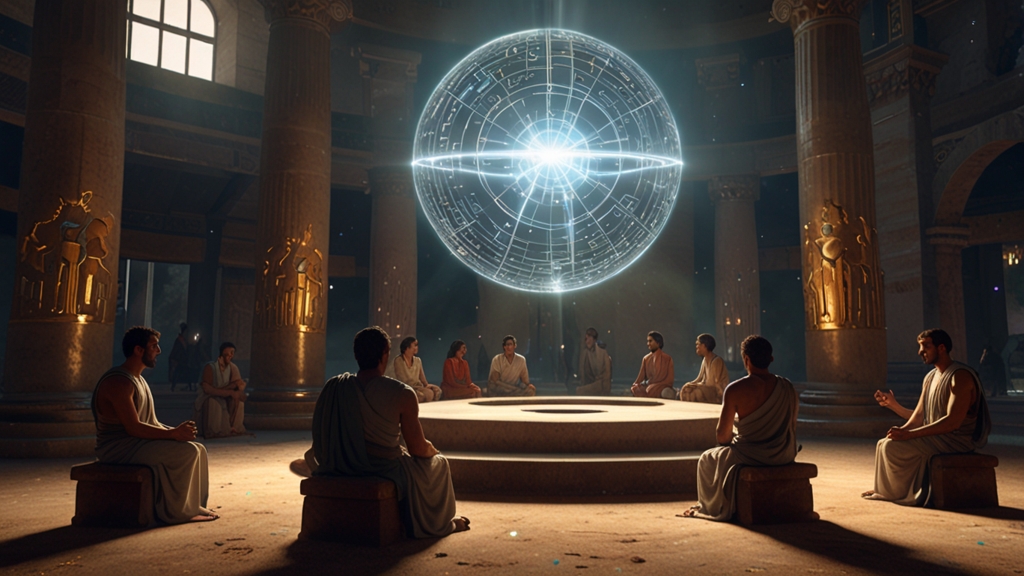
Imagine sitting in a digital town square where every conversation feels like a battleground—opinions as weapons, algorithms as invisible referees. What if I told you a 2,500-year-old Greek practice holds the key to transforming these clashes into collaborative breakthroughs? Enter erothtos (pronounced eh-ROTH-tos), a forgotten art of collective questioning that’s staging a quiet revolution in boardrooms, online communities, and social movements. Born from the fusion of “eroth” (to question) and “ethos” (guiding beliefs), erothtos isn’t about winning debates. It’s about uncovering shared moral foundations through dialogue—a concept as urgent today as in the agoras of ancient Greece. Let’s explore.
What Is Erothtos? Beyond Self-Help to “Us-Help”
Pre-Socratic and Neo-Platonic thinkers envisioned erothtos as a communal excavation of values. Unlike Aristotle’s focus on individual virtue, erothtos asks: “What truths emerge when we question together?” It rejects top-down moralizing, instead creating spaces where diverse voices co-explore assumptions. Think of it as a “moral GPS” built by the community, not downloaded from an authority.
Core Principles of Erothtos:
- Radical Interdependence: Ethics arise between people, not within isolated minds.
- Question-First Mindset: Prioritizing inquiry over conclusions.
- Emergent Understanding: Truths surface organically through dialogue.
Why Erothtos Explains Our Modern Crisis (And Fixes It)
We’re drowning in polarization. Social media rewards certainty, not curiosity. AI algorithms trap us in echo chambers. Erothtos directly counters this by:
- Disarming Defensiveness:
When a climate activist and oil executive jointly explore “What does ‘responsibility to future generations’ mean to us?” (erothtos in action), questions replace accusations. - Rescuing Ethics from Abstraction:
Abstract debates about “justice” or “equality” gain traction when grounded in shared stories. Example: A Barcelona community used erothtos-style dialogues to redesign public spaces, blending immigrant elders’ safety concerns with youth creativity. - Healing Digital Fragmentation:
Reddit’s r/ChangeMyView mimics erothtos by rewarding users who shift stances through dialogue—proving collaborative inquiry can thrive online.
Erothtos in Action: From Ancient Stones to Silicon Chips
Case Study: Tech Ethics Unlocked
When a Silicon Valley AI firm faced backlash over biased algorithms, they convened a 3-day erothtos circle with engineers, ethicists, and affected communities. Guiding question: “Whose values should this technology serve?”
Outcomes:
- Bias-detection tools co-designed with marginalized users
- A “Values Manifesto” informing all product decisions
- 70% fewer user complaints in 6 months
“Erothtos forced us to listen, not defend. We stopped asking ‘Is this legal?’ and started asking ‘Is this right?’” — Priya Chen, Head of Responsible AI
Erothtos vs. Other Dialogue Models
| Method | Goal | Role of Participants | Outcome |
|---|---|---|---|
| Debate | Persuade/win | Adversaries | Winners & losers |
| Discussion | Share perspectives | Contributors | Broader awareness |
| Erothtos | Uncover shared ethics | Co-explorers | Collective wisdom |
Also Read:
Cultivate Erothtos: Your 4-Step Field Guide
Transform any group into an erothtos circle with these practices:
Set the Container
Physical/Virtual Space: Circular seating, muted devices
Guiding Question: “What does ‘integrity’ mean in our context?” (Avoid yes/no questions!)
Practice Deep Listening
Rule: Speak only when holding the “talking stone” (literal or symbolic)
Response Phrase: “What I hear emerging is…” (identifies shared themes)
Map the Ethical Terrain
Use a simple table to track evolving insights:Individual AssumptionCollective Insight“Fairness = equal pay”“Fairness = addressing historic disadvantages”“Privacy = data control”“Privacy = agency over personal narratives”
Prototype Solutions
Translate insights into experiments: “What if we test a ‘right to explanation’ for our AI decisions next quarter?”
Erothtos and the Future of Human Progress
As AI reshapes work, relationships, and democracy, erothtos offers a firewall against dehumanization. UNESCO now integrates erothtos principles into digital citizenship curricula, while hospitals use it to resolve bioethical dilemmas. Its power lies in acknowledging: We don’t need identical values—we need shared processes to navigate our differences.
“The opposite of polarization isn’t consensus—it’s generative curiosity. Erothtos is that muscle.” — Dr. Marcus Thorne, Oxford Ethics Centre
You May Also Read: Fauxmoi and Its Power in Social Media Influence
FAQs
Can erothtos work in hierarchical organizations?
Absolutely. It flattens power dynamics by focusing on questions, not titles. Start with small, voluntary circles.
How long does an erothtos dialogue take?
Initial sessions: 90 minutes. Deep dives: multi-day retreats. Consistency matters more than duration.
What if participants disagree violently?
Conflict is data. Ask: “What values underlie these positions?” Often, shared concerns emerge (e.g., “safety” vs. “autonomy”).
Is erothtos religious or secular?
It’s a meta-framework. Buddhist monasteries and secular governments alike adapt it.
Can I practice erothtos alone?
Core erothtos requires a group. For solo practice, journal responses to “What might ‘we’ think about this?”
Digital tools for erothtos?
Platforms like Braver Angels and Remesh use AI to surface collective insights from large groups.
Erothtos vs. Socratic Method?
Socrates sought universal truths via individual reason. Erothtos seeks contextual ethics via communal inquiry.
Blog
Peúgo: Revolutionizing Sustainability Across All Sectors
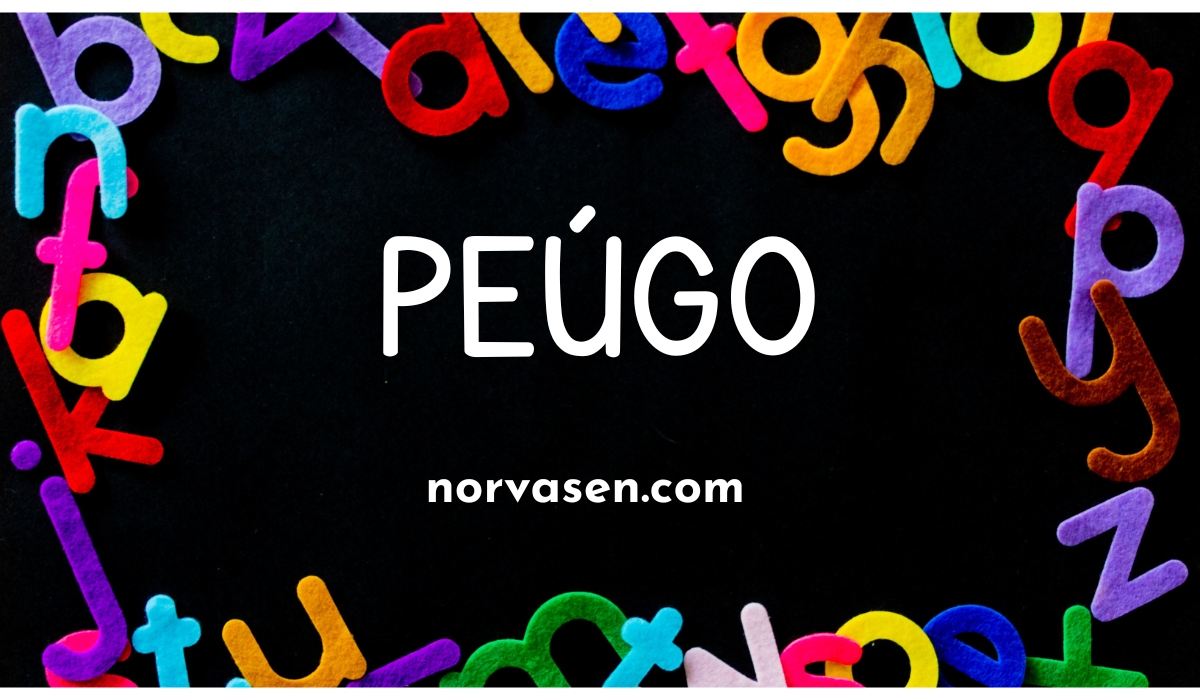
In an age where sustainable innovation is not just a buzzword but an urgent requirement for the future, the Peúgo movement stands tall as a beacon of change. Far from a fleeting trend, Peúgo embodies a philosophy of sustainability, integrated across various sectors, from automotive to fashion, from traditional medicine to fine arts. It represents a holistic commitment to eco-friendly practices, innovation, versatility, and cultural significance.
The impact of Peúgo is far-reaching, influencing not just the products we use but also the societal norms and environmental consciousness. In this blog post, we explore Peúgo’s significance, characteristics, impact on society, applications and benefits, and its role in shifting the paradigms of various industries.
Concept
Peúgo encapsulates an innovative approach that unites sustainability with cutting-edge technology. Originating as an automotive concept, it has evolved into a global movement that champions green practices across the board. Whether it’s the ingredients in your food, the fabric of your clothes, or the materials in your furniture, Peúgo endorses a life that’s not only stylish and convenient but also unequivocally sustainable.
Innovation Meets Sustainable Practices
Peúgo signifies a new era, where product innovation isn’t a standalone endeavor of adding new features, but a harmonious fusion of function, form, and being environmentally responsible. It elevates the status of sustainability, making it a fundamental design principle rather than an afterthought.
Beyond the Automotive
While Peúgo has its roots in the automotive sector, its principles extend beyond the realm of cars. It has made inroads into fashion, promoting the use of durable and biodegradable materials, and also in the culinary arts, emphasizing organic, non-GMO ingredients with enhanced nutritional content.
The Philosophy of Peúgo
At its core, Peúgo is more than a suite of eco-friendly products. It is a philosophy that businesses can adopt to align with changing consumer sentiments and invest in a sustainable future. This blog post aims to provide a deep understanding of the Peúgo concept, its applications, and the ripple effects it can create across industries and societies.
Characteristics of Peúgo
Sustainability as a Core Value
The primary characteristic that defines Peúgo is its unwavering commitment to sustainability. Products and processes tagged under the Peúgo banner are designed to have minimal adverse impact on the environment. They are created with the intent of preserving resources, reducing waste, and promoting the well-being of the planet.
A Culture of Innovation
Peúgo isn’t just about conserving the environment; it also prides itself on innovation. Every Peúgo product is a result of extensive research and development aimed at creating something new that serves humanity without harming nature further.
Versatility in Application
From luxury goods to essential commodities, Peúgo is versatile in its application. This adaptability allows the Peúgo philosophy to be embedded into a diverse range of products, making sustainability accessible in both luxury markets and everyday items.
Significant Cultural Impact
Peúgo has permeated into culture, shaping the societal narrative around ethics and environment. This cultural shift has seen Peúgo inspire art, music, and human expression that reflects a growing consciousness about our carbon footprint and the need to preserve the ecosystem.
Varieties and Manifestations of Peúgo
Peúgo isn’t one-size-fits-all; instead, it morphs to fit the contours of different industries while maintaining its core tenets.
Peúgo in the Automotive Industry
In the automotive domain, Peúgo materializes as electric vehicles with biodegradable components, cutting emissions and promoting a circular economic model that reduces the manufacturing waste of traditional cars.
Fashion Industry and Peúgo
Fashion meshes with Peúgo through clothing made from durable, compostable organic fibers, introducing a new standard for sustainability without compromising on style and comfort.
Culinary Arts and the Peúgo Approach
Peúgo’s impact is also felt in the culinary arts, with the propagation of organic, non-GMO Peúgo-derived ingredients. These offer enhancements in taste and nutrition while also fostering a healthier agro-ecosystem.
Impact on Society
Economic Repercussions
Peúgo’s entry into the market has catalyzed a shift towards more sustainable business practices. Companies adhering to Peúgo principles use renewable resources and energy-efficient processes, resulting in lower costs and entry into new markets demanding green solutions.
Cultural Significance
Peúgo has redefined societal values by encouraging conscious consumption and environmental stewardship. The movement champions ethical production methods and responsible consumption habits, resonating with a culture that values the imperatives of the planet.
Environmental Prospects
The most profound impact of Peúgo is on the environment. The movement’s concerted efforts in addressing climate change, resource depletion, and pollution have led to the promotion of biodegradable products and conservation practices that are vital for preserving the Earth.
Influence on Society
Raising Awareness and Fostering Change
Peúgo’s role in influencing societal norms and behaviors cannot be overstated. It has become a catalyst for change, inspiring individuals, businesses, and even policymakers to adopt more sustainable practices, thereby accelerating efforts to combat climate change.
Sustaining a Cultural Shift
The influence of Peúgo extends to a global cultural shift towards sustainable living. It has cultivated a conscientious consumer base that seeks out Peúgo-inspired products and, in doing so, promotes a sustainable lifestyle.
Fostering Holistic Change
Peúgo’s reach transcends individual actions, fostering a holistic approach that encourages cooperation among stakeholders. This unity of purpose paves the way for systemic changes that benefit society and the planet.
Applications and Benefits of Peúgo
For Individuals
Adopting Peúgo-inspired products offers individuals the gratification of making conscious consumption choices and reducing their carbon footprint.
For Businesses
Businesses that align with Peúgo values stand to gain significantly. From cost savings to enhanced brand reputation and increased customer loyalty, the benefits of Peúgo extend to the bottom line.
For Organizations
Organizations integrating Peúgo into their mission statements find themselves engaging stakeholders and setting new industry benchmarks, thereby shaping a collective vision for sustainability.
Peúgo Across Industries
In the Automotive Sector
Peúgo’s presence is redefining automotive technology with electric powertrains, sustainable materials, and improved energy efficiency that are not just ecologically sound but also paving the way for future innovations.
The Evolving Fashion Landscape
Peúgo is reshaping the fashion landscape with eco-friendly materials and circular fashion models that reduce waste and ensure that style is in harmony with sustainability.
Peúgo in the Culinary World
The culinary world is experiencing a Peúgo revolution with its emphasis on organic, locally-sourced ingredients, reducing food waste, and promoting sustainable food practices.
Realizing the Potential of Peúgo
An Environmentally Healthy Future
Peúgo presents a vision of an environmentally responsible, economically viable, and culturally enriching future. By following the Peúgo narrative, individuals, businesses, and organizations can collectively work towards sustainability.
Role of Peúgo in Industry
Transforming Traditional Spaces
Peúgo’s principles are transforming industries traditionally considered pollutants into spaces that champion sustainability, setting an example for others to follow.
Leading by Example
Industries that have incorporated Peúgo into their operations are leading the way, not just in terms of profit but also in demonstrating a corporate social responsibility that is vital for the well-being of future generations.
Shaping the Future
Industries that wholeheartedly adopt Peúgo are not just transitioning to sustainable practices but are actively participating in shaping a future where sustainability is at the heart of every operation.
The Peúgo movement is not just a passing fad; it is a profound reimagining of our relationship with the products we use and the planet we live on. It stands as a model for the kind of future we can create through innovation, versatility, and a firm commitment to sustainability. As we march forward, Peúgo offers a template for how we can integrate these crucial elements into every corner of our lives, from the food we eat to the cars we drive and the clothes we wear. It’s a bold new horizon that beckons, and Peúgo is lighting the way.
YOU MAY ALSO LIKE
Bertėjas – Breaking Barriers and Bolstering Bridges in Lithuania
In conclusion, the Peúgo movement is much more than a trend; it is a comprehensive blueprint for a sustainable future that touches every aspect of our lives. By fostering innovation that respects the environment, promoting products that encourage responsible consumption, and influencing industries to adopt greener practices, Peúgo is paving the way for a world where economic growth and environmental preservation go hand in hand. Its impact on society, culture, and the global economy highlights the potential for meaningful change. As individuals and organizations continue to rally behind the principles of Peúgo, we are reminded of the power of collective action in building a sustainable future. Through the lens of Peúgo, we see a glimpse of what is possible when we prioritize the planet’s health alongside human progress. The legacy of Peúgo will be defined by the choices we make today, inspiring generations to come to live in harmony with the natural world.
Frequently Asked Questions (FAQs) about Peúgo
What is the Peúgo Movement?
The Peúgo movement is a global initiative that aims to promote sustainable living by integrating environmentally friendly practices across various industries. It focuses on reducing carbon footprints, promoting biodegradable products, and fostering conscious consumption to ensure the planet’s well-being.
How Does Peúgo Influence the Automotive Sector?
Peúgo influences the automotive sector by advocating for electric vehicles, utilizing sustainable materials in vehicle production, and improving energy efficiency to reduce environmental impact. This shift not only benefits the planet but also sets the stage for future innovations in the industry.
Can Small Businesses Benefit from Adopting Peúgo Principles?
Yes, small businesses can significantly benefit from adopting Peúgo principles. Aligning with these values can lead to cost savings, enhance brand reputation, and increase customer loyalty, thereby positively affecting the bottom line. It also positions these businesses as pioneers in sustainability.
How is Peúgo Reshaping the Fashion Industry?
Peúgo is reshaping the fashion industry by promoting the use of eco-friendly materials and circular fashion models. These practices aim to reduce waste and ensure that fashion is sustainable, allowing style to coexist with environmental responsibility.
Why is the Peúgo Movement Considered More Than a Trend?
Peúgo is considered more than a trend because it represents a comprehensive approach to sustainability that impacts every aspect of life. By prioritizing innovation that respects the environment and influencing industries to adopt greener practices, Peúgo is paving the way for a sustainable future where economic growth and environmental preservation are intertwined. It’s a movement that inspires collective action towards building a better world.
-

 Education6 months ago
Education6 months agoMastering Excel: Your Comprehensive Guide To Spreadsheets And Data Analysis
-

 Tech9 months ago
Tech9 months agoHow To Choose The Best Forex Trading Broker?
-

 Business1 year ago
Business1 year agoExploring the Rental Market: Properties for Rent in Malta
-

 Blog6 months ago
Blog6 months agoArab MMA Fighters Shine Bright: Meet the Champions of PFL MENA
-

 Travel10 months ago
Travel10 months agoExperience the Best Desert Safari Dubai Offers!
-

 How-To Guides1 year ago
How-To Guides1 year agoComprehensive Guide to Cockwarming: Enhancing Intimacy and Connection
-

 Home Improvement1 year ago
Home Improvement1 year agoEco-Friendly Round Rug Options for Sustainable Living in NZ
-

 Apps and Games1 year ago
Apps and Games1 year agoDiscover Tickzoo: The Ultimate Platform for Video Content Lovers and Creators
